Report
Introduction
This is the fifth full edition of Bain’s India Philanthropy Report. Our previous reports covered a range of topics on the sector: In 2011 and 2012, we covered major trends spurring philanthropy in India, with a focus on the rise of young philanthropists and the nonprofit causes they were helping to propel. Our 2013 report demystified the complexities of impact measurement in the philanthropic space and identified the factors that ensure each rupee is used as effectively as possible. In 2014, we focused on reproductive, maternal, newborn, child and adolescent health (RMNCH+A) in India and the need for the entire ecosystem to evolve to address critical issues in healthcare.
The focus of this year’s report is the evolution of philanthropy in India to date and some recommendations for how to sustain and build on its recent momentum. Our report identifies areas for change and offers insights into how stakeholders can address new opportunities.
We explore the two sides of philanthropy—donors and nonprofit organisations—and the complex dynamic between them. We do this by:
- Defining characteristics of different types of donors and nonprofit organisations
- Identifying donor expectations from nonprofit organisations
- Understanding the segmentation in the space of both donors and nonprofit organisations
- Identifying critical challenges that nonprofit organisations face
- Developing an agenda for different stakeholders as they look ahead
For sharper insights into the issues, problems and solutions facing nonprofits, we surveyed 377 high-net-worth individuals (HNWI) across eight major cities as well as roughly 50 nonprofit organisations (77 employees and 46 senior staff, including founders and CEOs). We supplemented these findings with the results of detailed interviews we conducted with approximately 15 HNWIs and leaders of nonprofits and charitable foundations.
Executive summary
The philanthropy space has grown considerably since Bain & Company’s first report in this series, the India Philanthropy Report 2010. In fact, the country has added more than 100 million donors since 2009. Donors are also contributing more and donating to a larger pool of nonprofit organisations, giving philanthropy a much higher public profile. All of this has put philanthropy in India significantly ahead of that in other countries with similar levels of prosperity.
This growth trend shows no signs of slowing. In fact, more than a third of current donors expect their donations to increase in the next five years. And as the nation implements the corporate social responsibility (CSR) regulations under the new Companies Act, there will be a positive disruption in the philanthropy space, bringing in more corporate donors and bringing about greater accountability and transparency. However, the potential scope for philanthropy in India remains vast, with the country facing many unaddressed social development problems.
To sustain and grow interest in philanthropy, there are several hurdles that nonprofit organisations must address. Donor apathy and a mistrust of nonprofit organisations and their operations are widespread. The space is dominated by a large number of “disconnected” donors who donate out of guilt or due to personal relationships rather than a personal connection to the cause. They demand low overheads due to their lack of faith in nonprofits. There are also a large number of small, unsophisticated nonprofits that lack adequate transparency, sophistication and organisational capacity, which make them less credible to donors.
The result is a two-tiered philanthropy space:
- Tier 1 has sophisticated donors working with sophisticated nonprofit organisations to create superior outcomes. Donors in this tier give consistently once they have established a positive relationship with a nonprofit.
- Tier 2 is defined by a negative spiral in which disconnected donors and smaller unsophisticated nonprofits are trapped. Donors are perpetually seeking causes to support, and nonprofits are in a permanent pursuit of donors and money to support themselves.
This two-tier dynamic is unproductive. A shift from Tier 2 to Tier 1 would likely lead to support for a wider set of causes, as well as fuller support for those causes, than at present. To make this happen, three major shifts must occur:
- Greater cause orientation among donors, which will increase loyalty to the nonprofits and a broader role beyond “arm’s length” giving
- Greater transparency in nonprofits, with sustained communication to donors on results and financials
- Greater collaboration and resource sharing among nonprofits to use resources better, given donor scepticism regarding overheads and in-house spending
All stakeholders will have a role to play in transforming the space. Donors will have to be “activists”, contributing beyond their cash through guidance and oversight. Nonprofits must inspire cause loyalty among donors. They can do this by communicating impact and by involving donors beyond passively contributing money. Support networks need to develop collaboration and sharing models through which nonprofits can access knowledge, learning and benefits of scale. Lastly, the space needs to develop standard criteria to assess nonprofits based on effectiveness (results and impact) and efficiency (overheads). This will enable donors to access a trusted source of information as they donate.
If this doesn’t happen, India will continue to have a stratified philanthropy space—which works for a privileged few causes and nonprofits but fails others.
The high growth in philanthropy since 2010
Five years ago, when our first India Philanthropy Report was published, India had a nascent philanthropic environment. Seeds long planted had just begun to break the surface, and the ecosystem for active and sustained giving was still developing. Since then, the nation’s philanthropic donors and charitable donations have grown vastly in number, value and public profile.
In 2009, only 14% of the adult population across India donated cash, and some 12% donated their time (see Figure 1). For an entire year, philanthropic activity received a mere 426 mentions in the media. In the five years since, the philanthropic space has been completely transformed. Today, a deeper pool of donors donates larger amounts of money to a greater number of players in the nonprofit sector.
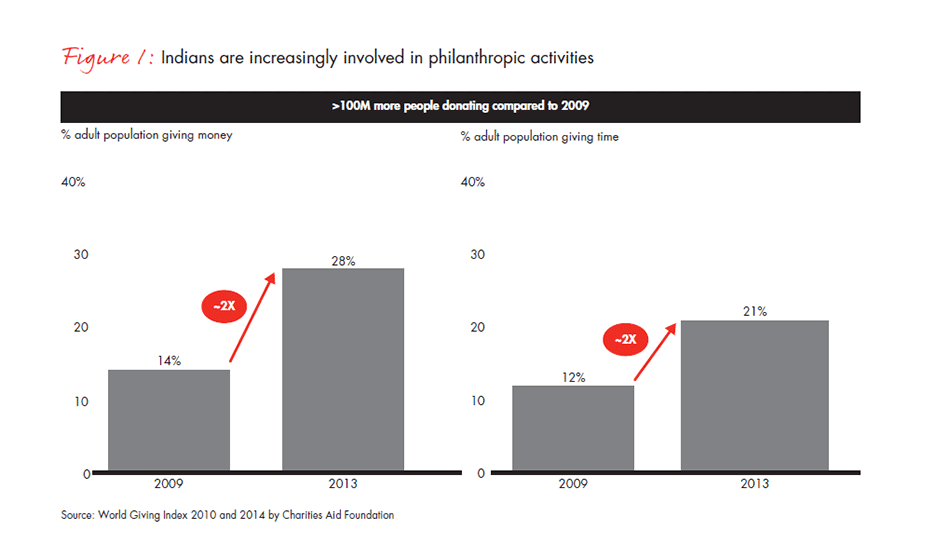
In 2013, for example, 28% of the adult population donated money and 21% donated their time. This means a staggering increase of more than 100 million more Indians making donations in cash or time than in 2009.1 Media reporting of philanthropy is also now double what it was five years ago. What in 2009 was a tiny sapling is now a resilient tree in bud, awaiting its first blooms.
A strong economy, growing wealth and greater global interest in India have underpinned this growth in the philanthropic activity of individuals and corporations. The potential pool of donors—India’s HNWI and ultra-high-net-worth individual (UHNWI) population—grew at 12% CAGR during 2011–2013, with UHNWIs growing faster than in other developing markets such as China or Brazil in 2012–2013. HNWIs’ wealth grew at 6% per year, from $477 billion in 2009 to $612 billion in 2013.
What is remarkable is that philanthropic donations in India are ahead of donations in other developing countries. India is a global outlier, with a larger percentage of its population making charitable donations than other countries at its level of prosperity elsewhere in the world (see Figure 2). Even in developed countries like the US, charitable donations do not exceed the average for its level of per capita GDP.
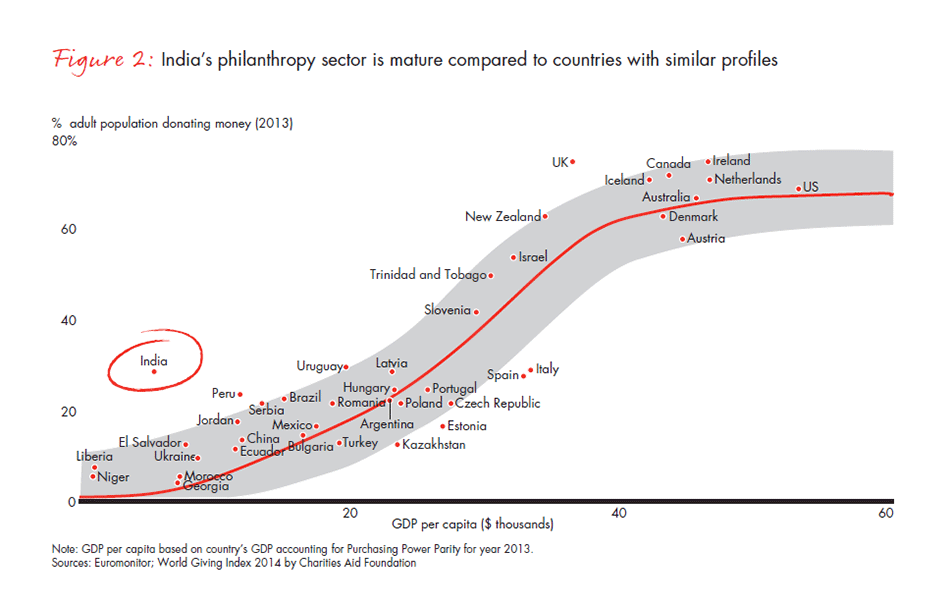
Reflecting greater global interest in India, foreign philanthropic funding has also more than doubled, climbing from $0.8 billion in FY04 to $1.9 billion in FY12. This is due in part to the government’s focus on social spending in areas such as education, child welfare and public health, which aligns well with the priorities of international foundations. The Bill & Melinda Gates Foundation, for example, has invested approximately $1 billion in India during the past decade—in public health programmes concerned with maternal health, polio and tuberculosis eradication as well as within its established focus area of HIV through the successful Avahan AIDS Initiative launched in 2003.
The supply side of the philanthropic ecosystem has also kept pace. Indian philanthropic foundations are now an established part of the space. We have seen many new domestic foundations like the Reliance Foundation and NALCO Foundation (both established in 2010) set up in the past five years.
The nonprofit sector and its support networks have driven philanthropy in India. Several sources suggest that there are more than 2 million nonprofit organisations operating in this space currently. The number of nonprofits registered under the Foreign Contribution Regulation Act (FCRA) increased from approximately 30,000 to approximately 44,000 in the past 10 years in response to the increase in global philanthropic interest in the country. Organisations have also improved in quality. Today, the nonprofit sector is a better networked space that permits quicker learning and sharing of best practices and has a greater capacity to respond to donor concerns than ever before.
As the new Companies Act is implemented, much-needed disruptive change will arrive. The Act not only makes contributions by large profitable companies mandatory but is also likely to improve the governance and oversight of the nonprofit space by stipulating programmatic donations from corporations and oversight from their CSR boards. The law now requires that companies formulate clear CSR policies and disclose them publicly through an annual report or their company website.
Initial signs of this change are emerging, with many companies deploying dedicated resources for the philanthropic space. For example, Coal India cleared a proposal to recruit about 120 officers for its CSR activities to comply with the Act. Other companies, such as Siemens, that don’t spend 2% on CSR are thinking of starting small and then scaling up to reach the target in a sensible and sustained manner. Estimates by several sources suggest that the Act may produce $2.5 billion to $3.3 billion in corporate contributions to the philanthropy space.
As a consequence of this growth, India is now No. 69 on the World Giving Index, up from No. 134 in 2010. In a few short years, India has moved from the bottom to the middle of the pack.
Still a long way to go . . .
Despite the strong progress India has made, it lags substantially behind other developed markets such as the US and UK. India lacks the same depth of donors or public profile as these higher-ranked countries. In the UK, for instance, 74% of people made charitable donations in 2013 compared with 28% in India. And, as a measure of public profile, there were 11,000 media reports on philanthropy in the US in 2013, compared with a mere 1,000 in India across the same time period. However, this lag can easily change as Indian philanthropists rise to meet the demand for charitable contributions, fill the development gap by working with a larger number of grassroots organisations and systematically address the country’s most pressing issues.
There is enormous potential for donors and nonprofits to effect change in India. Despite much progress in recent years, the country still lags in social development. The scale of some of these problems is such that without an active philanthropic community supporting the government’s own work, it is unlikely that incremental progress will occur. The extent of the problem is reflected in the stark numbers for basic social indicators. For example, India’s maternal mortality ratio is 190 per 100,000 live births versus 8 in the UK. Its immunisation rate for diphtheria, pertussis and tetanus (DPT) is only 72%, compared with 94% and 96% in the US and UK, respectively. Only 36% of India’s population has access to improved sanitation facilities.2 A symptom of larger gender disparities, the number of women in tertiary education is only 78 for every 100 men.
In addition, there are many underfunded or unfunded causes in need of attention from philanthropists. Our survey of HNWIs and the nonprofit sector shows that some causes attract disproportionate donor attention, while others receive scant notice. More than 40% of the HNWI survey respondents donate to causes like education and child welfare, whereas less than 15% donate to causes that support the environment and the arts (see Figure 3).
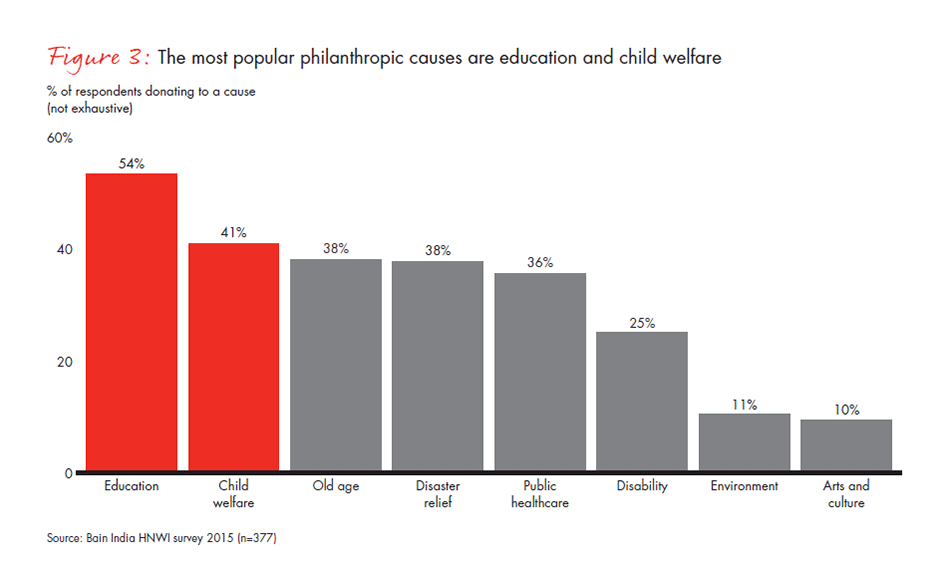
We have also seen, over the past five years, several causes that have caught donor attention only momentarily, as media-led interest in a subject rises and falls. For example, saving tigers, the cause célèbre of 2009, hasn’t seen much traction recently. The recent upsurge of interest in the cause of improved sanitation appears to be following a similar path.
Looking ahead, the philanthropic space in India holds great promise. There is substantial momentum which, coupled with a potential turnaround in the Indian economy, will turn out new philanthropists and higher charitable contributions from existing donors. A substantial portion of existing donors are well engaged and constantly looking for ways to increase their contributions. More than 40% of current donors we surveyed told us that they planned to increase their philanthropic contributions over the next five years (see Figure 4).
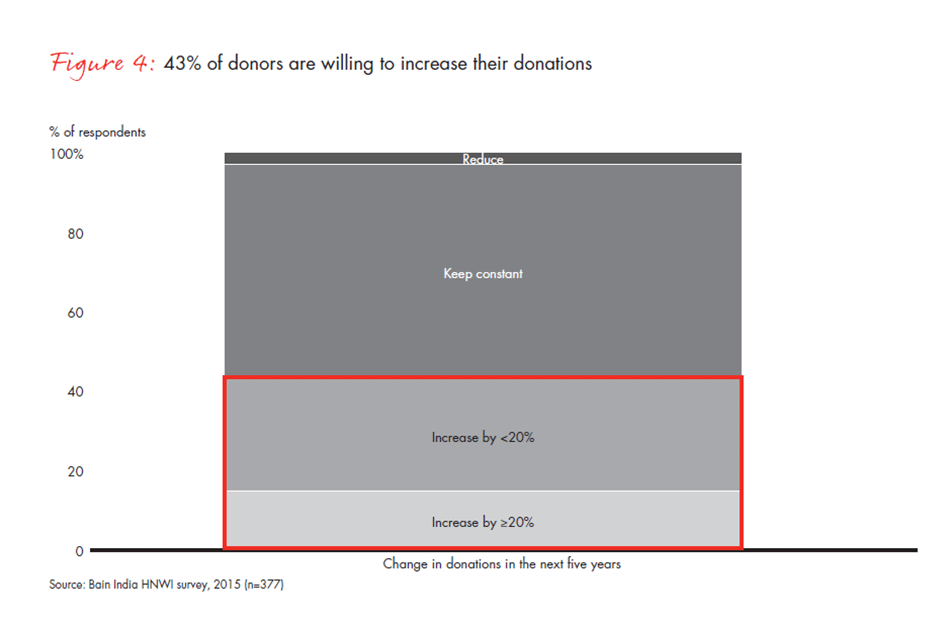
However, the journey is unlikely to be smooth. There are obstacles to overcome before the space can enter its next phase of growth.
Bottlenecks to reaching full potential
India needs to maintain its growth trajectory of philanthropic donations. Failing to do so could lead to undesirable outcomes for philanthropy in India and Indian society at large. To continue to grow as it has over the past five years, all stakeholders will need to address the following challenges.
Lack of credibility and donor apathy are major impediments to the progress of philanthropy in India
A main cause of underfunding is the perceived lack of credibility and trustworthiness on the part of nonprofit organisations. At present, only a few nonprofit organisations enjoy the confidence of their donors. Some organisations are able to build high profiles and showcase the outcomes of their work to donors, which translates into higher and more sustained donor interest in those organisations and their causes. However, donors do not think very highly of most nonprofits and related agencies in this space. Some 50% of donors we surveyed said that they did not know of a sufficient number of credible organisations or foundations through which they could spread their donations. More than 60% of donors said that for them to increase their contributions, nonprofit agencies must display greater transparency and accountability.
Despite visible strides in philanthropy over the past several years, donor apathy remains a concern. There is a very large base of “disconnected” donors who donate out of guilt or personal relationships rather than cause orientation (see Figure 5). How the nonprofit space evolves will depend to a great extent on how it is able to activate and direct this group of donors.
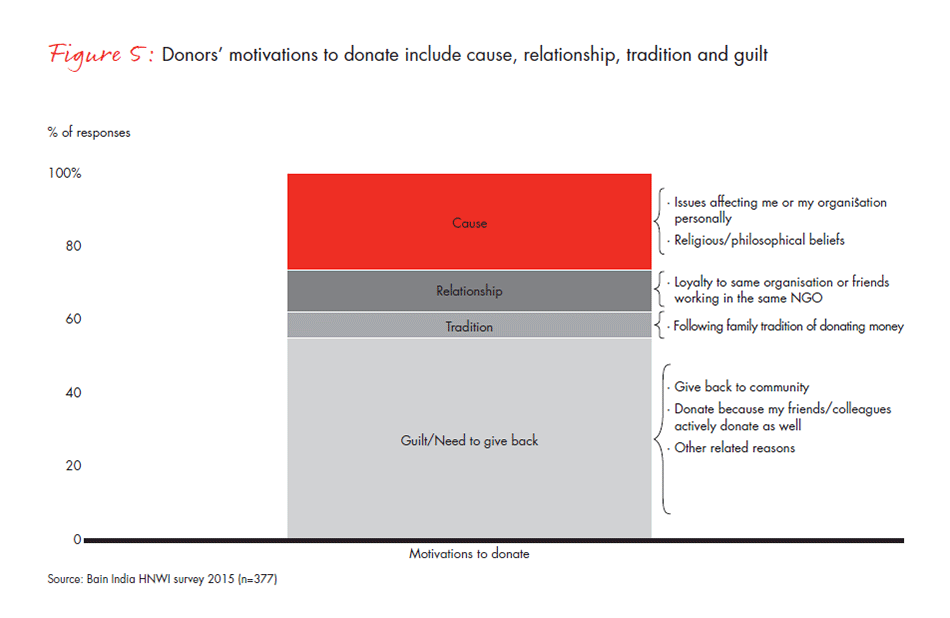
Emergence of a two-tiered space
As things stand, the low credibility of nonprofit organisations and donor apathy have turned philanthropy in India into a “two-tiered” space (see Figure 6).
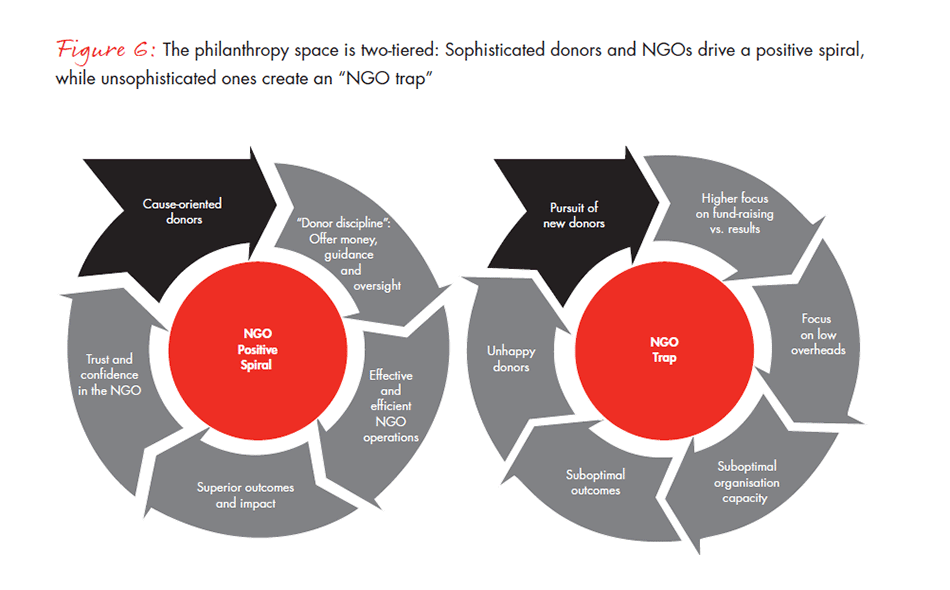
Tier 1: Sophisticated donors and nonprofits driving a positive spiral
Tier 1 comprises sophisticated donors who work with sophisticated, highly credible nonprofit organisations. Sophisticated donors are typically wealthier and have given consistently and for longer periods of time to causes they strongly identify with (see Figure 7). They not only contribute cash but also provide oversight and guidance.
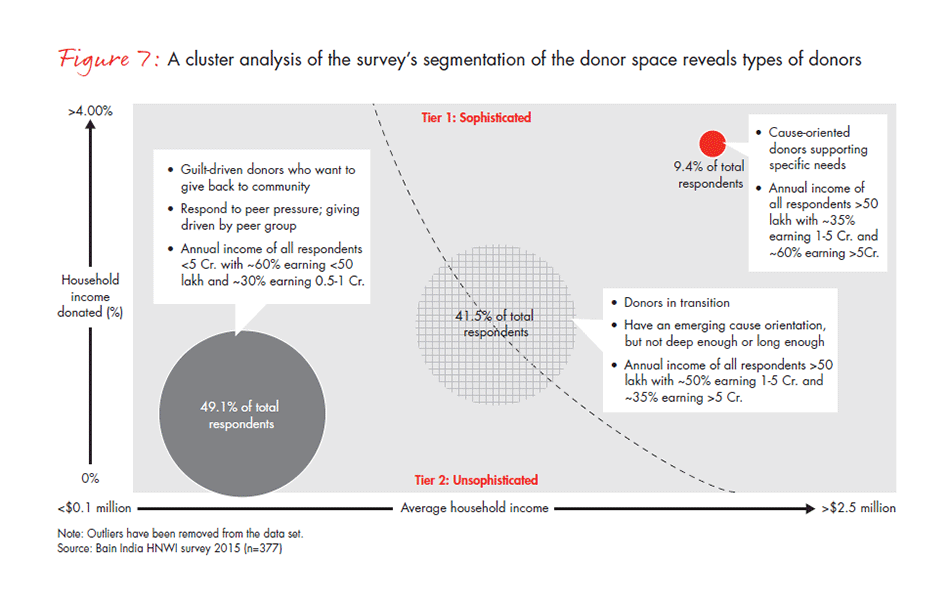
Sophisticated nonprofit organisations tend to be larger and have the organisational capacity and discipline to deal with sophisticated donors. As a result, they tend to produce superior outcomes that in turn attract many more sophisticated donors. This puts the nonprofit on a positive spiral of organisational growth, increased capacity and social impact.
The very large number of repeat donors in Tier 1 reinforces this positive spiral. A vast majority of the larger trusted nonprofits have high numbers of repeat donors. Moreover, 64% of them said that they have received repeat donations from more than 50% of their donors (see Figure 8). However, only 31% of small nonprofits have repeat donors as the majority of their donors.
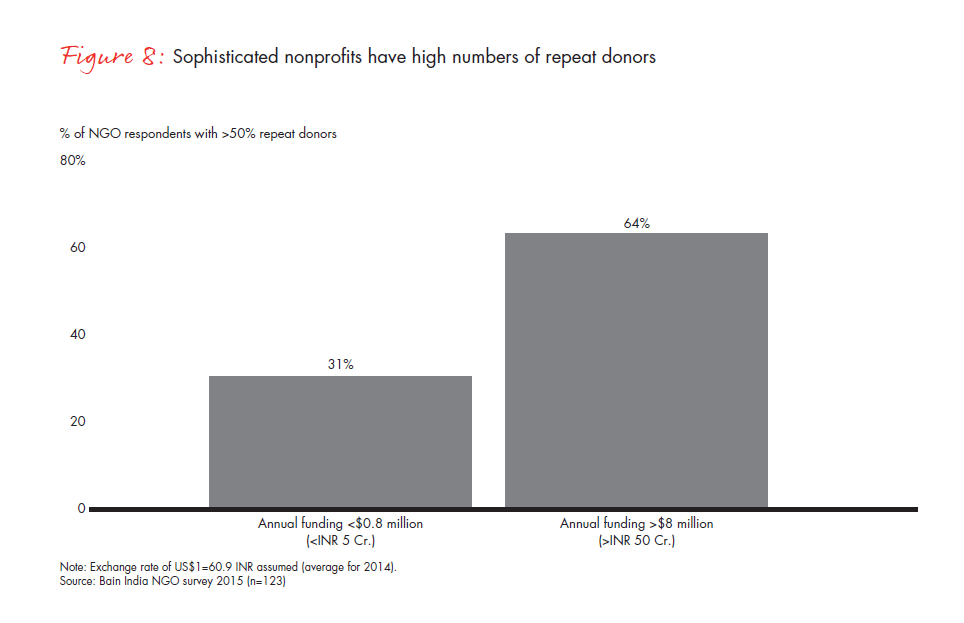
In Tier 1, however, there is a risk of donor interest being captured by a relatively narrow set of causes, which then tend to get a disproportionate share of contributions and most of the media attention.
Tier 2: Unsophisticated donors and nonprofit organisations creating the “NGO trap”
The Tier 2 space comprises unsophisticated donors who donate out of a sense of guilt and are constrained by a lack of information about which organisations to donate to and how. Guilt-driven donors tend to react to specific events (for example, popular campaigns). Typically, they have less experience donating and are also relatively less wealthy. A majority of donors in India belong to this category and donate based on personal relationships or media-driven trends rather than enduring interest in a cause (see Figure 9).
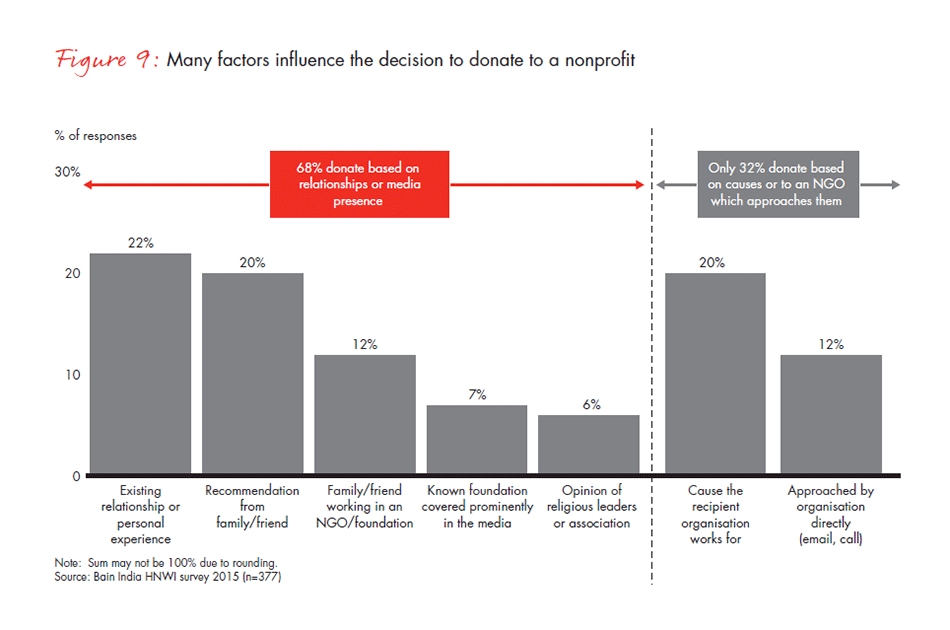
Tier 2 also includes unsophisticated nonprofit organisations. These organisations have poor organizational capabilities and reporting structures, making them less credible and unable to attract Tier 1 donors. This leaves them trapped in a perennial fund-raising cycle, “chasing the next 1 lakh rupees”, as a veteran in this space put it. Our survey found that 83% of the respondents from larger nonprofit organisations were satisfied with the level of funds they had, whereas only 63% of respondents from the smaller ones said they had sufficient funds (see Figure 10).
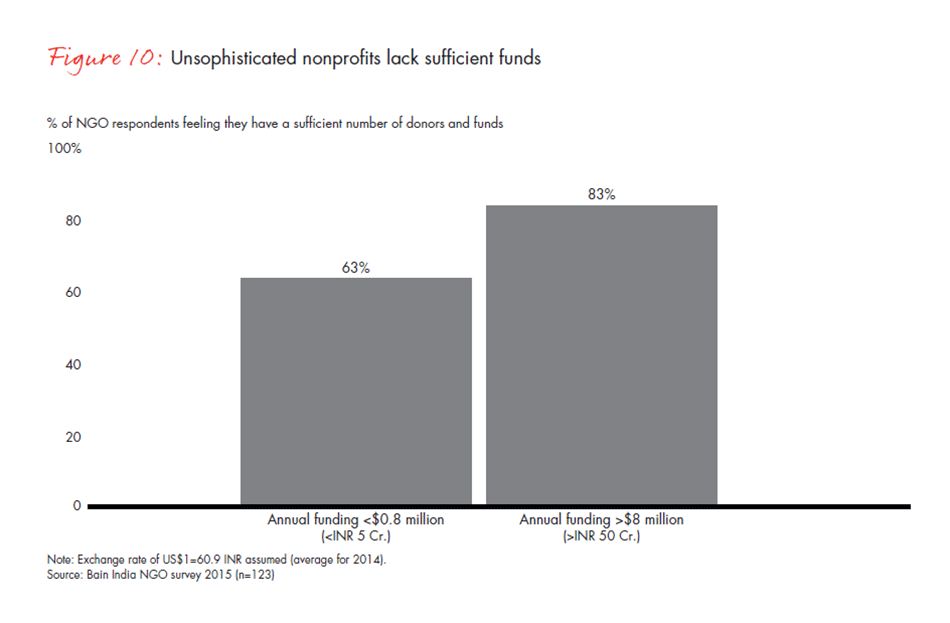
The unsophisticated nonprofits get trapped in a negative spiral—a constant pursuit of new donors, which leads to a reduced focus on results in favor of fund-raising. They attract relatively new donors who seek low overheads, which in turn means there are fewer resources to build organisational capacity. This results in suboptimal outcomes and leaves donors dissatisfied and unwilling to donate again. Consequently, these organisations’ pursuit of new donors continues.
Clearing the bottlenecks
To merge the two tiers and create a positive spiral, it is important that all stakeholders—nonprofit organisations, support networks and donors—come together and work on critical elements. Three areas of focus should be: greater cause orientation among donors, better transparency in nonprofit functioning and collaboration of resources. Focusing on these areas will ensure that the next wave of growth in philanthropy is smooth and that every donation creates maximum benefits on the ground.
Greater cause orientation among donors. Cause-oriented donors are more loyal. This means they provide consistent funding to the nonprofit organisations they choose and, hence, reduce the organisation’s focus on fund-raising. Their involvement goes beyond cash donations; they provide oversight and bring in discipline, helping nonprofits operate more effectively and efficiently. Such donors can also be force multipliers for fund-raising by harnessing their own credibility and relationships to act as aggregators of disconnected donors and, over time, may emerge as evangelists for the causes they champion.
Transparency in nonprofit functioning. The philanthropy space in India is sorely lacking in trust. One of the top findings from our survey and interviews was that donors seek trust, so they gravitate towards relationships rather than causes. This reality is in many ways responsible for the fragmentation of the philanthropy space into two tiers. Greater transparency in nonprofit functioning, which may add slightly to overhead costs, goes a long way in building trust with donors. Some basic requirements of greater transparency are practices such as tracking, reporting and communicating results and details of fund utilisation.
Collaboration for greater efficiency and impact. Donors rate transparency, demonstrated impact and low overheads as their top expectations of nonprofit organisations (see Figure 11). Nonprofits need to use available resources and talent for the best outcomes. Collaboration and resource sharing across nonprofits is the way forward. This will lead not only to optimal resource use but also to the dissemination of best practices. Collaboration, however, is not easy. Most nonprofits, particularly the smaller Tier 2 ones, tend to be founder-centric, displaying a propensity to control and stay entirely focused on their specific grassroots segment. To change this, nonprofits and stakeholders that are open to collaboration should work to draw attention to its benefits. Some 64% of our NGO respondents said there was a need for partnerships among different stakeholders in the philanthropy space.
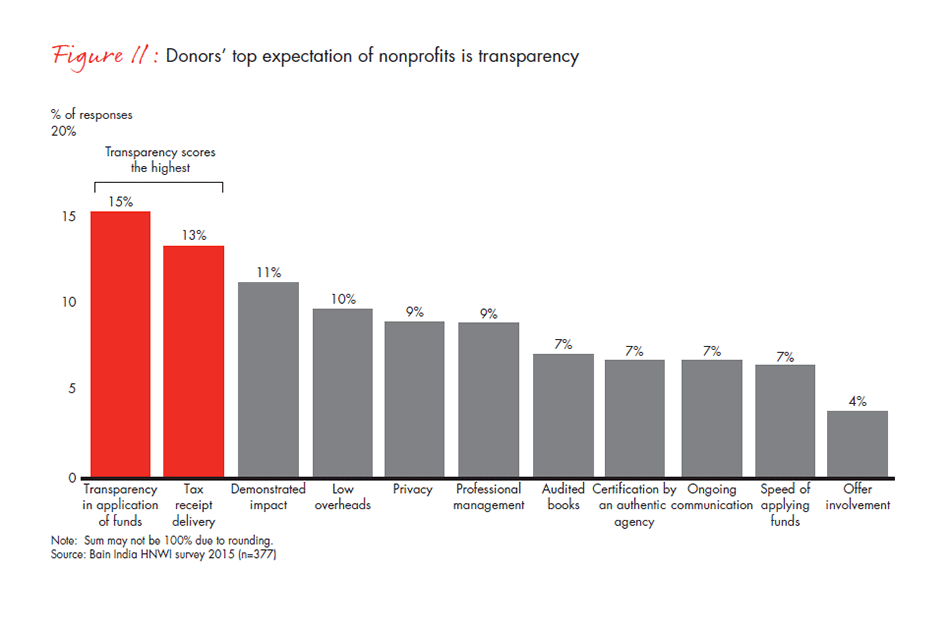
Agenda for the future
To ensure the above areas are addressed, it is important to define clear roles for all the stakeholders in the philanthropic space. Activist donors should encourage discipline among nonprofit organisations, which will increase transparency. Nonprofits need to increase cause orientation among donors. Support networks must enable the collaboration of resources and define a standard set of criteria to evaluate nonprofits (see Figure 12).
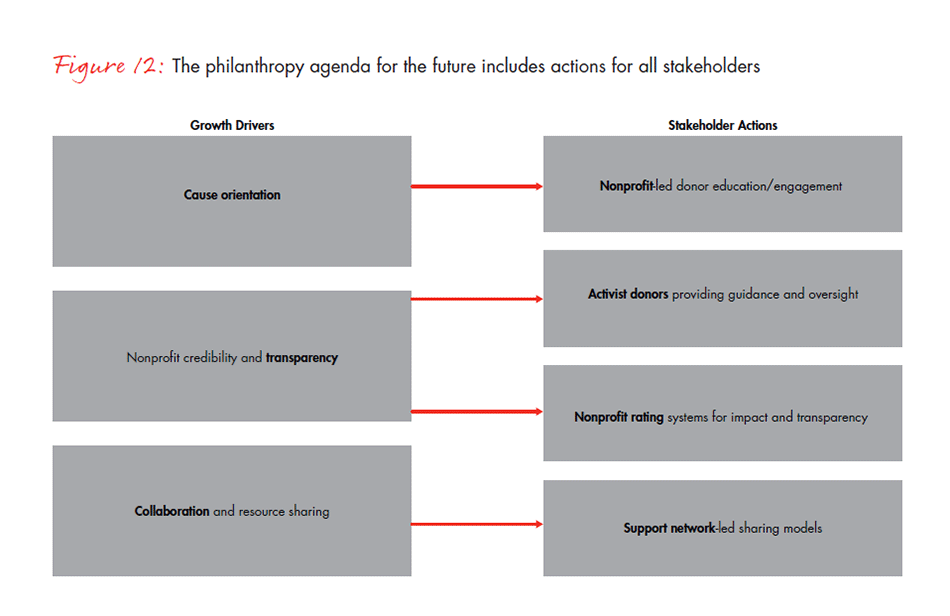
Activist donors. The philanthropy space in India needs more “activist” donors: either individuals or corporations who not only donate money but also provide their time, skills and resources to help nonprofit organisations build their capabilities. This includes oversight support, which in turn would encourage “donor discipline” and help nonprofits to improve their effectiveness and efficiency. However, there is a fine line between oversight and policing, and it will be critical for donors to stay on the correct side of that line.
Nonprofit organisations. Nonprofit organisations need to make donors more cause oriented. They can do this by working more closely with donors rather than maintaining relationships at arm’s length. The more a donor sees a nonprofit in action, the more likely he or she is to see the value of its work and to become more consistently involved with the cause it champions. Nonprofits need to maintain appropriate levels of communication on operations, tracking project development and reporting results.
Support networks. Support networks are critical to making nonprofits more effective. These networks need to experiment with and develop “sharing models” for nonprofit organisations to help them use limited overheads in a manner that allows them to do what they do best: make a positive change at the grassroots level. They can experiment with shared back-end and support functions across organisations, which would offer them scale benefits and help them adopt best operational practices.
Standards to assess nonprofits. A standard set of criteria for assessing nonprofit organisations would go a long way in making the philanthropy space in India more donor friendly. In the corporate world, rating agencies provide a valuable service by assessing companies, allowing shareholders to stay informed and bringing transparency to the space. Nonprofit organisations need their own version of this: defined criteria for assessing their effectiveness (results and impact) and efficiency (overheads). This will make the trade-offs of donating to one organisation or another clear to potential donors.
Independent agencies and support networks can work with nonprofits of all sizes to settle on a standard set of criteria for assessment. A set of standard criteria that also considers willingness to collaborate and learn may be a way forward. We have seen such examples in other countries. Independent agencies such as Charity Navigator in the US evaluate charitable organisations, creating a more efficient and responsive philanthropic marketplace in which donors and nonprofits can work in tandem.
Conclusion
Although philanthropy in India has evolved greatly since 2010, most stakeholders acknowledge that much more needs to be done. The CSR regulations under the new Companies Act will increase corporate philanthropy, and the nonprofit sector must be ready to absorb the new resources to create maximum impact on the ground.
At present, donors have difficulty finding credible nonprofit organisations, and the bulk of the nonprofit sector is trapped pursuing a large number of disconnected donors. As a result, philanthropy in India has become two-tiered, with sophisticated donors choosing to work with a small number of highly credible nonprofit organisations, and disconnected donors and unsophisticated nonprofits trapped in an unending and unproductive pursuit of new causes and new funders, respectively.
This dynamic is counterproductive. To escape this trap, all stakeholders must work towards merging the two tiers to produce more sophisticated donors and more trusted nonprofit organisations. Activist donors will have to demand discipline from nonprofits, and nonprofits will have to increase cause orientation among donors. Support networks created by donors will play a significant role in engendering resource sharing and collaboration among nonprofit organisations. As we see it, the future of philanthropy in India is a dynamic space where a deeper cause-oriented donor pool, with a larger number of activist donors, is energised by communicative and collaborative nonprofit organisations that deliver the greatest impact. The space is beginning to blossom—now all it needs is to be carefully tended.
Arpan Sheth is a partner with Bain & Company in Mumbai. He leads the firm’s Private Equity practice in India. Dinkar Ayilavarapu is a principal with Bain & Company and is a member of the firm’s Healthcare practice based in New Delhi. Anant Bhagwati is a partner with Bain & Company in Mumbai. He leads the Sales Excellence capability in India and is a member of the Technology, Media and Telecommunications practice.
1 The 100 million includes donors who donate to nonprofit organisations—charitable, religious—as well as individuals.
2 The improved sanitation facilities include flush and pour flush—to piped sewer system, septic tank or pit latrine—as well as ventilated improved pit (VIP), latrine, pit latrine with slab and composting toilet.











